

We may earn revenue from the products available on this page and participate in affiliate programs. Learn More ›
When you spot weeds in your lawn, your first instinct might be to grab a bottle and spray them to death—and you’re not alone. Worldwide herbicide sales are expected to reach nearly $8 million by 2025, and use of weed killers in home gardens and agriculture have been rising since 2000.
Weed killers are widely used, and that’s not a good thing. Herbicides are harmful to the environment, and almost certainly harmful to your health. In 2015, glyphosate, the active ingredient in Roundup, was reported to cause cancer, and that concern has spawned more than 125,000 lawsuits against Roundup’s manufacturer, Bayer. In 2019, nearly half of all acres of U.S. farmland growing corn and soybeans used glyphosate-based herbicides.
Although scientific reports vary on glyphosate’s cancer risk, property owners should be wary about using herbicides of any kind. We recommend that you engage in sustainable weed-control methods, or even learn to embrace some weeds as part of the natural environment. Ahead, learn about the types of weeds you might be seeing in your yard, and easy weed identification methods that will help you tell them apart. Some you may want to keep, and even eat. Those you can’t learn to live with can usually be tamed naturally—here’s how.
RELATED: Keep, Don’t Kill: 9 Weeds to Welcome
1. Dandelion (Taraxacum)
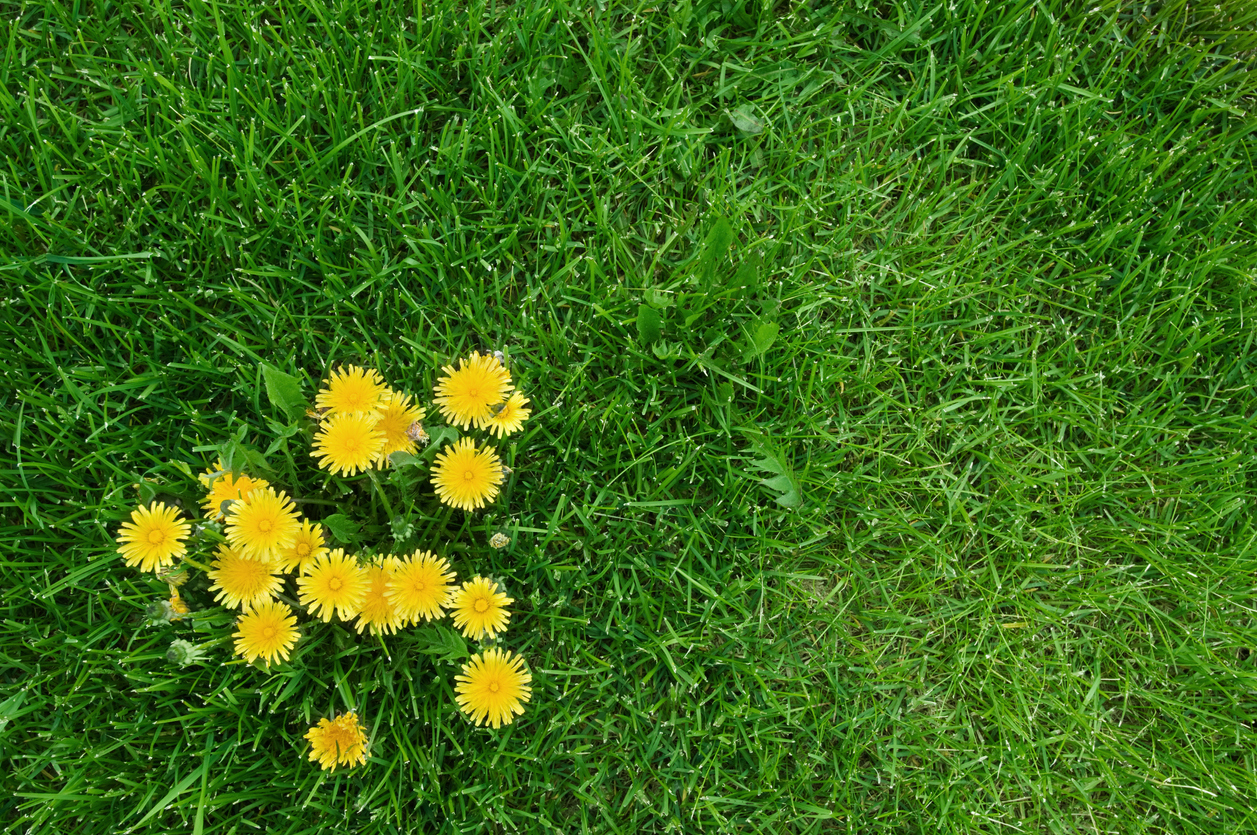
One of the most recognizable lawn weeds, dandelions have notched leaves and yellow flowers that become puffballs. Their thick taproot sinks deeply into the soil, making it difficult to pull the entire plant out by hand. That same taproot, however, helps keep soil aerated. Plus, dandelions bloom earlier than many ornamental flowers and provide essential nutrition for bees. All parts of the dandelion are also edible, so you can toss them in a salad or sauté them as long as you haven’t exposed them to any herbicides.
If you’re still determined to get rid of dandelions, try removing the growth above the ground. This effort eventually will cause the dandelion to die. Another method is to dig around the base of the weed with a deep weeding tool or knife before tugging it at the base and pulling it out of the ground. Using pre-emergent or post-emergent herbicides designed for use in the lawn should be a last resort.
RELATED: The Best Dandelion Killers, Vetted
2. Crabgrass (Digitaria spp.)
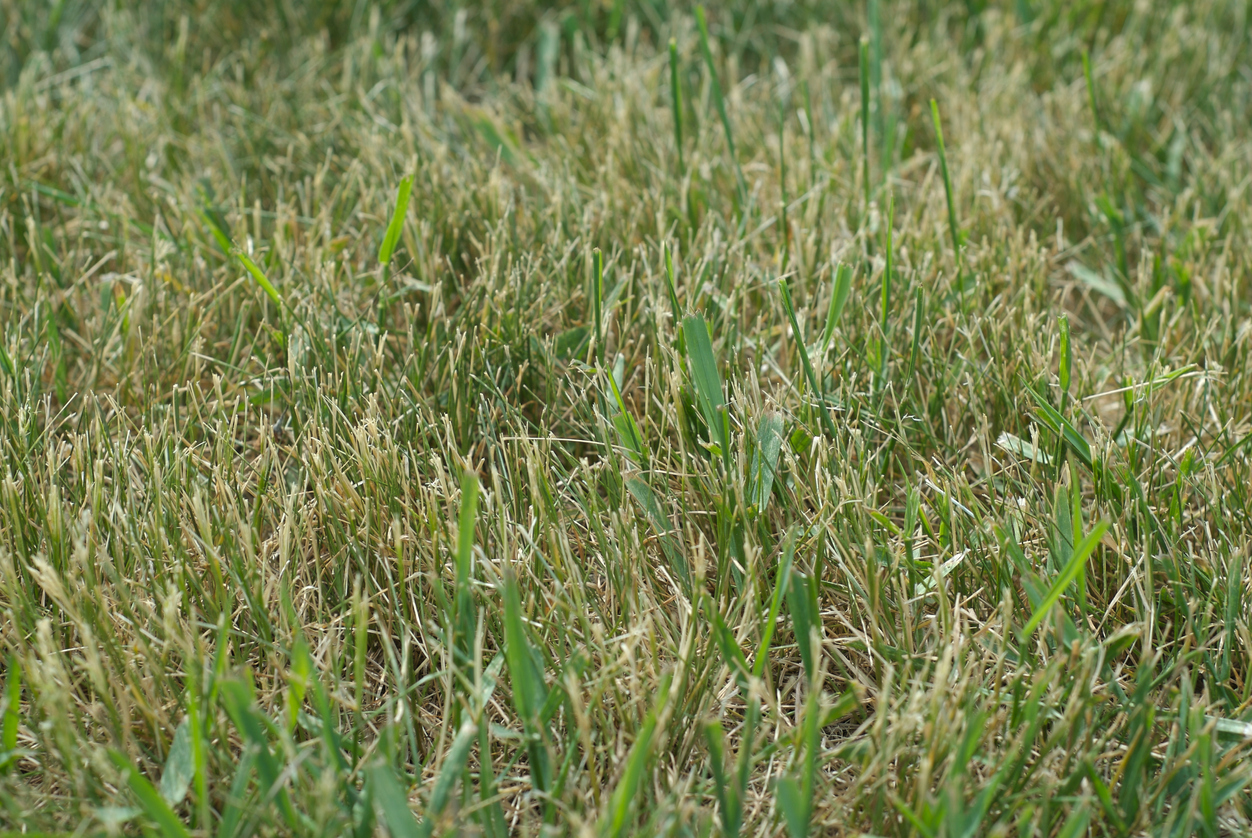
Producing 150,000 seeds per plant, crabgrass will take over your lawn. This annual grass pops up frequently around driveways and sidewalks where soil warms faster, triggering the germination of crabgrass seeds. In some areas of the U.S., crabgrass is foraged for human consumption, and is grown as hay for livestock.
When crabgrass proliferates in your lawn you can try hand-pulling it, but you’re unlikely to control it. The best way to get rid of crabgrass is to maintain a healthy, dense lawn cut at a height of 2 to 3 inches. You might also apply a pre-emergent herbicide for crabgrass around the time that forsythia shrubs bloom, before the seeds have a chance to germinate.
RELATED: 5 Things to Do With Weeds After You Pull Them
3. Clover (Trifolium)

This perennial ground cover produces three leaflets atop a long stem and small rounded white or pink flowers. If clover has creeped into your perfect suburban lawn, weigh its benefits before deciding whether to remove it. It’s an excellent pollinator plant and a favorite of honeybees. Clover doesn’t require fertilizer or water to remain green during drought conditions, and it has no serious pests. In fact, many lawn seed companies include clover in seed mixes because of its low maintenance and environmentally friendly attributes. To prevent a total clover takeover of the lawn, remove small clumps by hand or mow larger areas high, at 3 inches or more.
RELATED: 3 Good Reasons Why You Shouldn’t Kill Clover in Your Yard
4. Creeping Charlie (Glechoma hederacea)
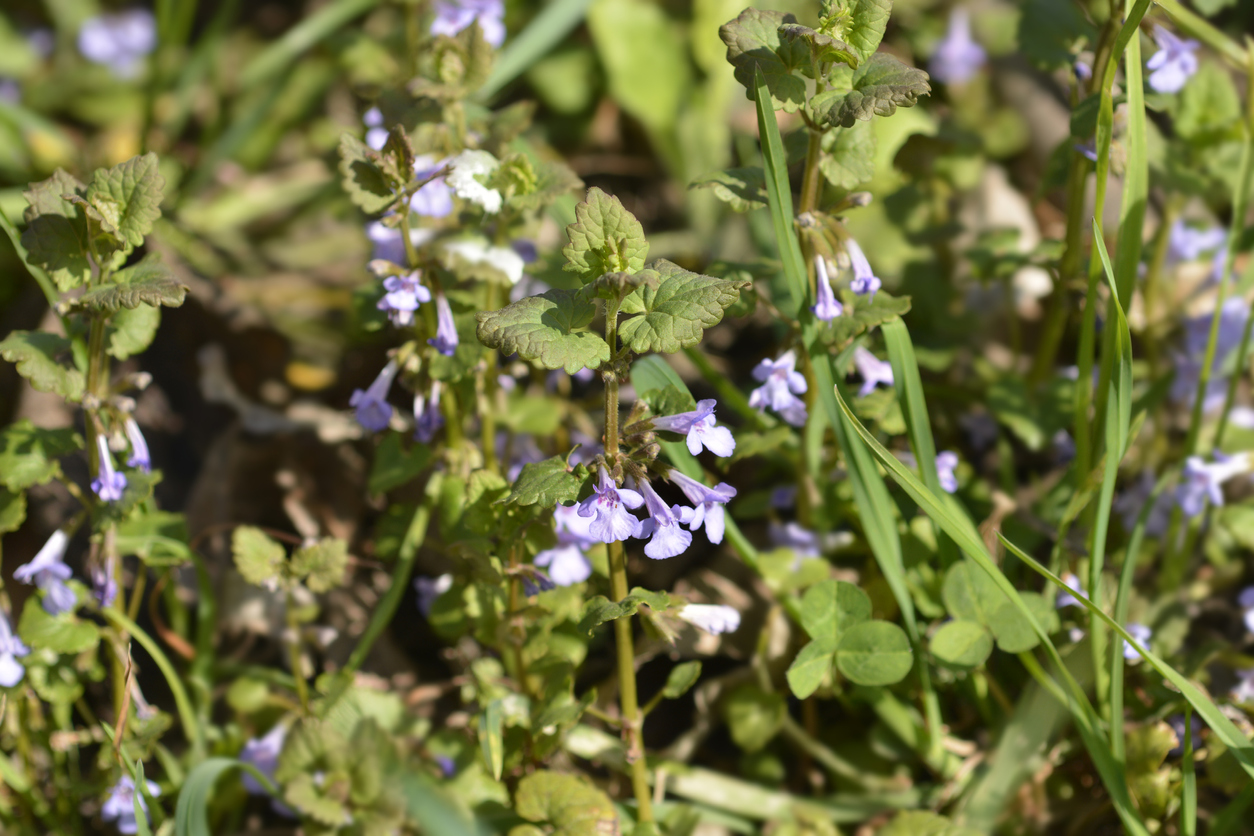
Also called ground ivy, creeping Charlie thrives in poorly drained shady areas that have fertile soil. The weed has rounded leaves with toothed margins that form along square stems. From April to June, blue funnel-shaped flowers that are loaded with pollen appear. The perennial herb packs plenty of Vitamin C and is purported to ease inflammation.
Getting rid of Creeping Charlie isn’t easy, particularly if it’s in a shady spot where there’s little competition from grass. To reduce the likelihood of Creeping Charlie taking up residence in your yard, one thing you can do is increase sunlight to weedy areas by pruning trees and shrubs. To control the weed’s spread manually, be sure to dig out all the stems and roots or the plant will grow back. If that fails (and it probably will, particularly if you’re trying to eradicate a large patch), apply a post-emergent broadleaf herbicide that contains dicamba from mid-spring to early summer and in middle to late fall.
RELATED: How to Make Weed Killer: 6 Methods That Are Both Natural and Effective
5. Purslane (Portulaca oleracea)
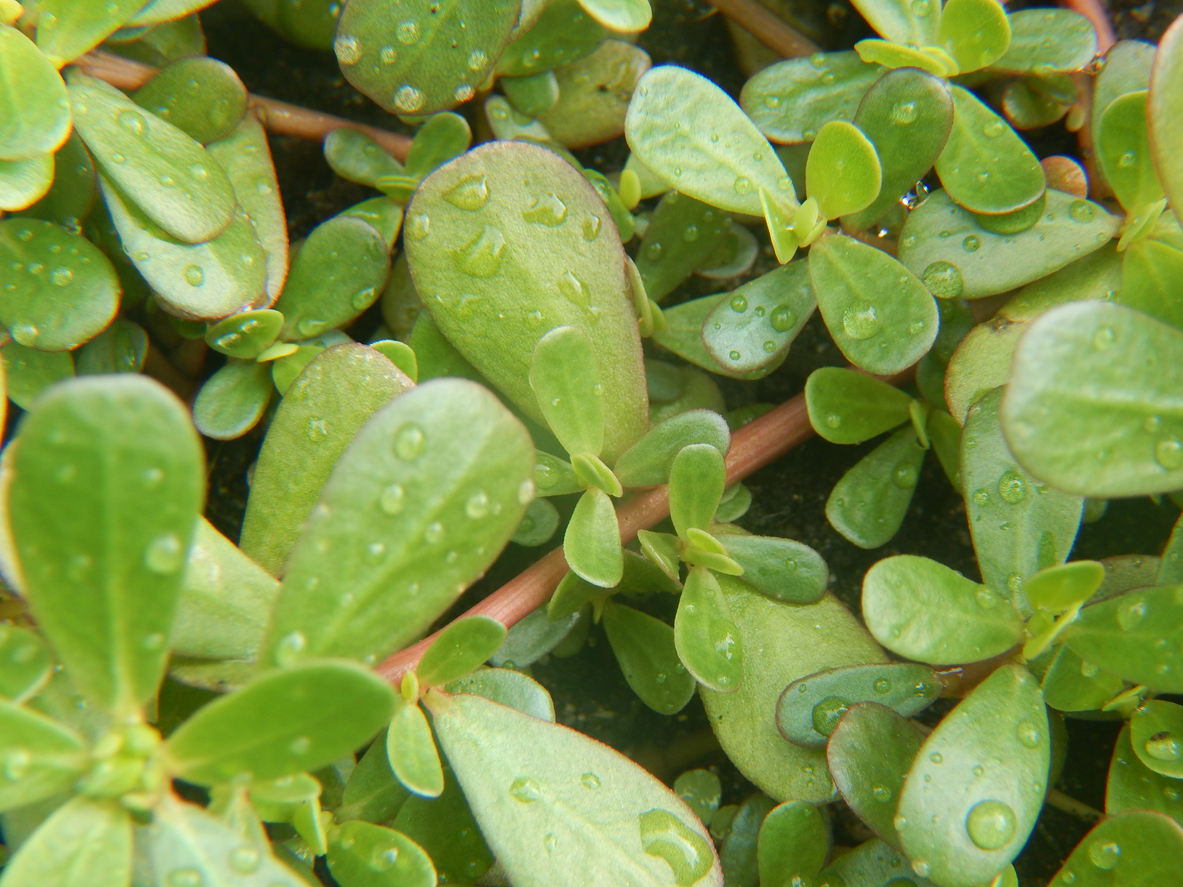
Closely related to moss rose, purslane’s succulent leaves and stems hug the ground, radiating out from a single taproot. It has small yellow flowers and can produce large mats in bare soil. This sturdy succulent is edible and rich in vitamins A and C, as well as omega-3 fatty acids. Its rich, lemony flavor tastes great in pesto, soups, or salad.
In turf or garden beds, purslane can pull moisture away from grass or other plants. Its seeds germinate best when soil temperatures reach 90 degrees Fahrenheit or more, which is why pre-emergent herbicides that you apply in early spring will likely have lost their efficacy by the time the seeds germinate. Pull these weeds by hand, making sure to remove all parts of the plant. Prevent purslane from gaining a foothold in your lawn by filling in bare spots with grass seed in the spring and fall.
RELATED: 13 Plants You Never Knew Were Weeds
6. Field Bindweed (Convolvulus arvensis)
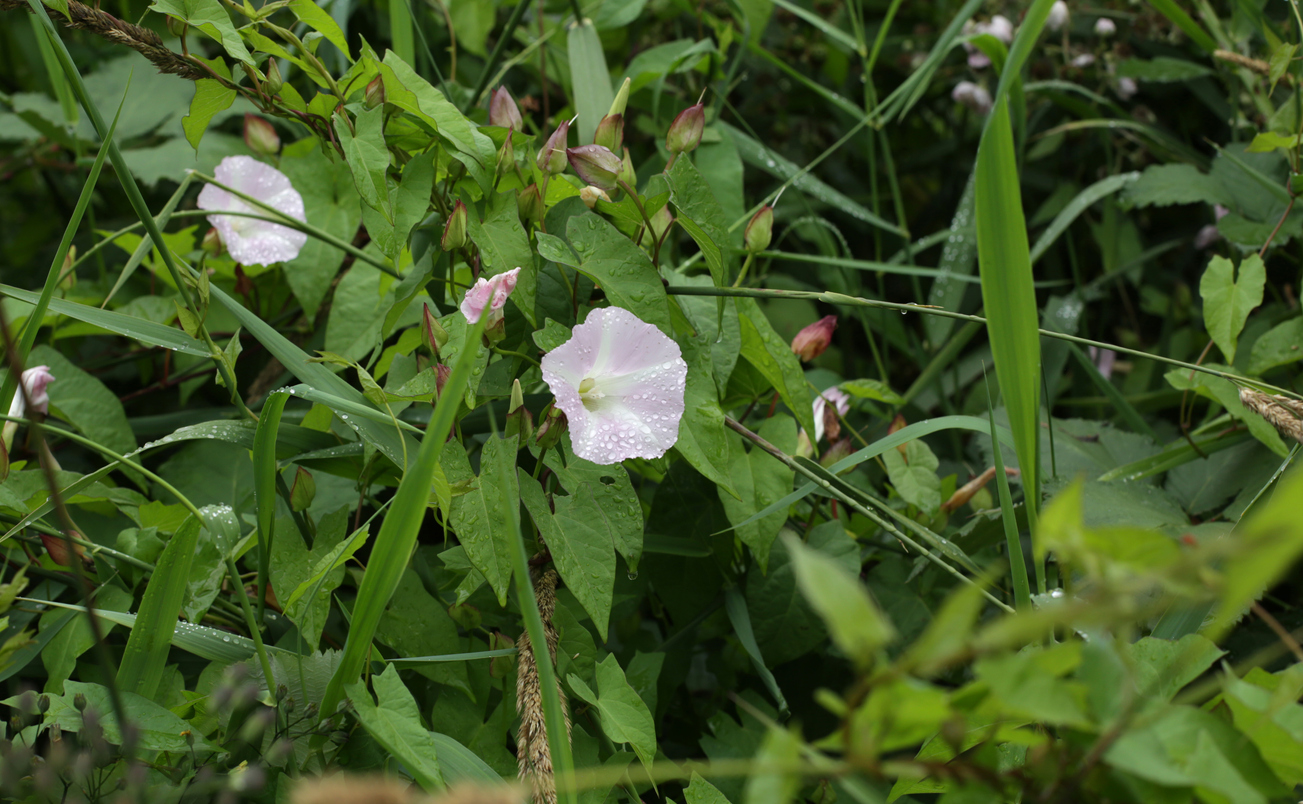
Field bindweed is a perennial lawn weed that is difficult to eradicate. This vining weed spreads via seeds and underground rhizomes. You’ll recognize it by its arrowhead-shaped leaves and flowers that resemble small morning glories. It wraps around plants and spreads across lawns so densely that it can smother and kill them.
Although its flowers can be attractive and the plant is said to have some medicinal benefits, field bindweed is problematic for lawns because it competes with the grass and plants that you actually want to grow, and its dense mats block light to them. Repeated pulling or hoeing before flowers appear (and seeds release) on field bindweed can help, but it won’t clear the weed entirely. Some post-emergent systemic herbicides are effective; be sure to read the label to confirm whether the product is effective on bindweed.
RELATED: Homemade Weed Killers and Preventative Treatments That Really Work
7. Lamb’s-Quarters (Chenopodium album)
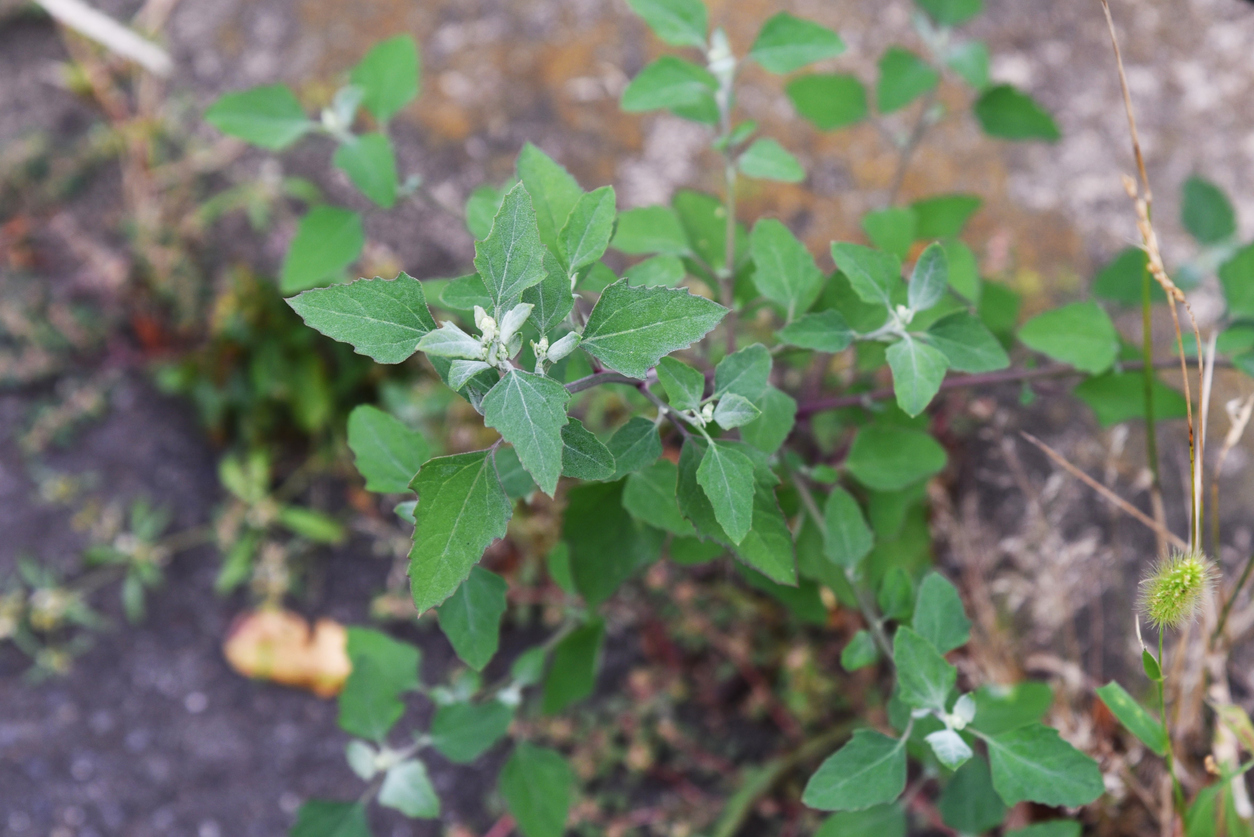
Dense, compacted soils are favored by lamb’s-quarters (also known as pigweed or goosefoot), which can grow up to 5 feet tall if it gets ample sun and moisture. How can you identify lamb’s-quarters? The leaves are egg shaped, toothed, pale green, and might be coated with a fine white powder (particularly if it’s new growth).
Lamb’s-quarters is a favorite of foragers for its edible leaves, which taste a bit like spinach. In some areas of the world, lamb’s-quarters is an agricultural crop favored for providing calcium, protein, and vitamins A and C. One of the disadvantages of pigweed, especially if you’re a vegetable gardener, is that it can harbor viruses that attack beets, lettuce, cucumber, and watermelon.
If you’re trying to get rid of lamb’s-quarters and hand-pulling isn’t an option, mow the lawn regularly to prevent the weed from producing seed. As a last resort, apply a pre-emergent herbicide to prevent germination.
RELATED: When to Apply Pre-Emergent Herbicide to Prevent Weeds in Your Lawn
8. Canada Thistle (Cirsium arvense)
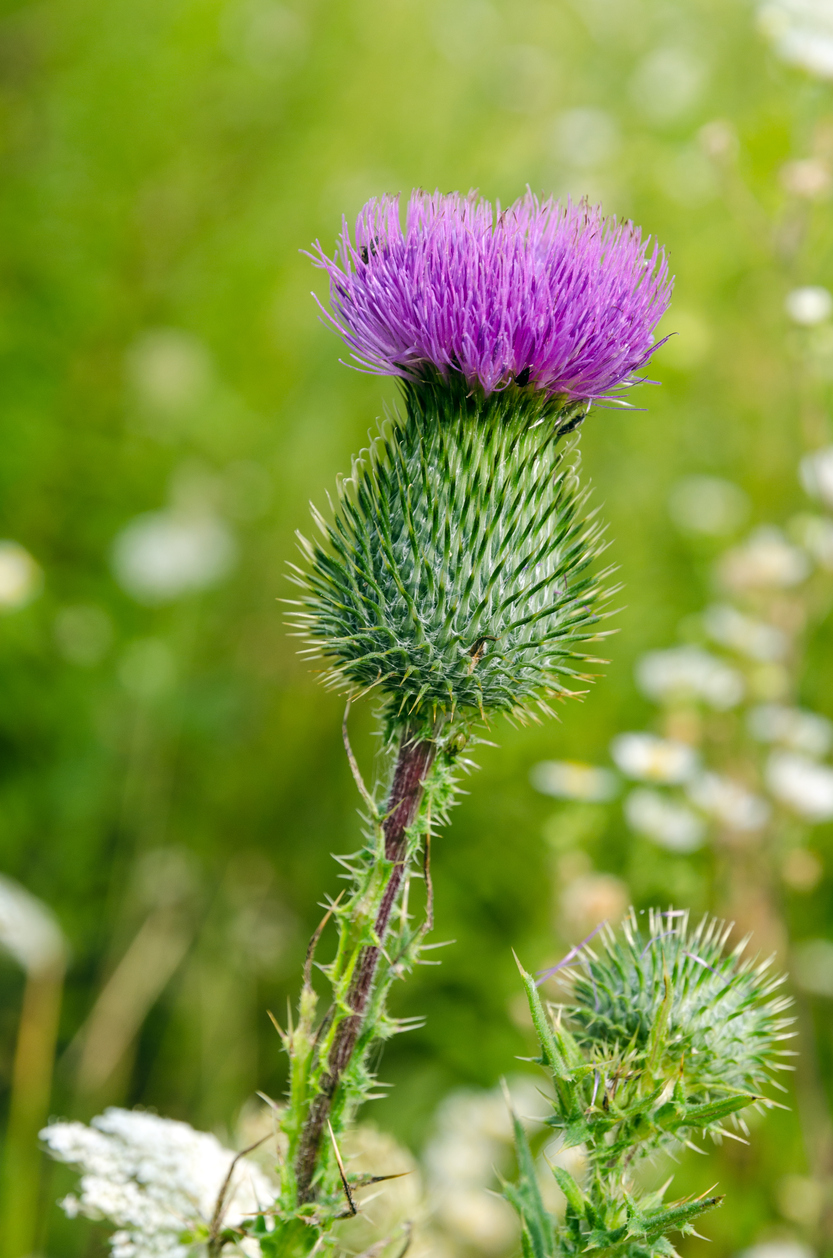
Sharp barbs on this tough perennial’s spear-shaped leaves are a visual reminder that it won’t go away easily. Canada thistle is hard to remove, requiring repeated efforts to eradicate the entire deep taproot. If even the smallest segment is left behind it will sprout a new plant, and in some cases, two new plants. Although Canada thistle seeds provide food for small birds and its leaves feed some small animals, it is otherwise destructive and invasive, and secretes toxins that can harm nearby plants.
Repeatedly mowing or cutting the lawn while wearing gardening gloves can slowly eradicate Canada thistle. Snip off the plant at its base and continue to do this until the weed no longer grows. When you remove the leaves, the plant can’t produce the food it requires to grow and produce seed. Chemical control is another option, but be sure to seek out a product that stops seeding and root growth.
RELATED: Does Vinegar Really Kill Weeds?
9. Wood Sorrel (Oxalis acetosella)
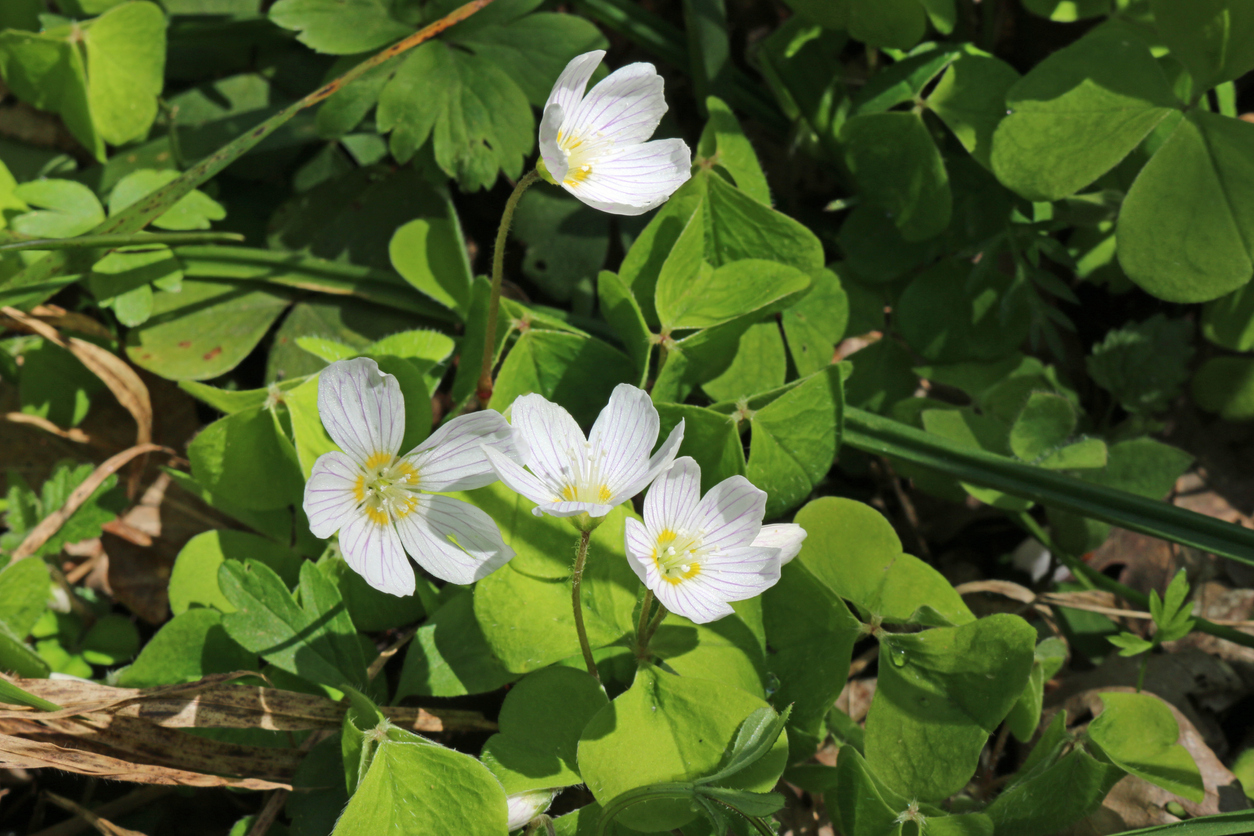
Wood sorrel or oxalis is a perennial weed that looks a lot like clover, except that it has yellow flowers. It forms a dense, low-growing mound that spreads by seed, stem fragment, or underground root. Although wood sorrel leaves are edible, sharp in flavor, and rich in vitamin C, they should be eaten only in small quantities or cooked first to reduce oxalic acid levels, which can be harmful.
Hand-pulling rarely works with oxalis because it leaves much of the plant behind. Your best bet to eradicate it from small areas is to dig it up by hand, but this course of action often takes several seasons to have an impact. For more immediate results, apply a broadleaf herbicide like dicamba to plants before they set seed. If you do resort to herbicide, be sure that the product you select won’t damage turf grass, follow the application instructions to the letter, and wear protective clothing and equipment when you apply it.
RELATED: Homemade Weed Killers and Preventative Treatments That Really Work
10. Puncturevine (Tribulus terrestris)
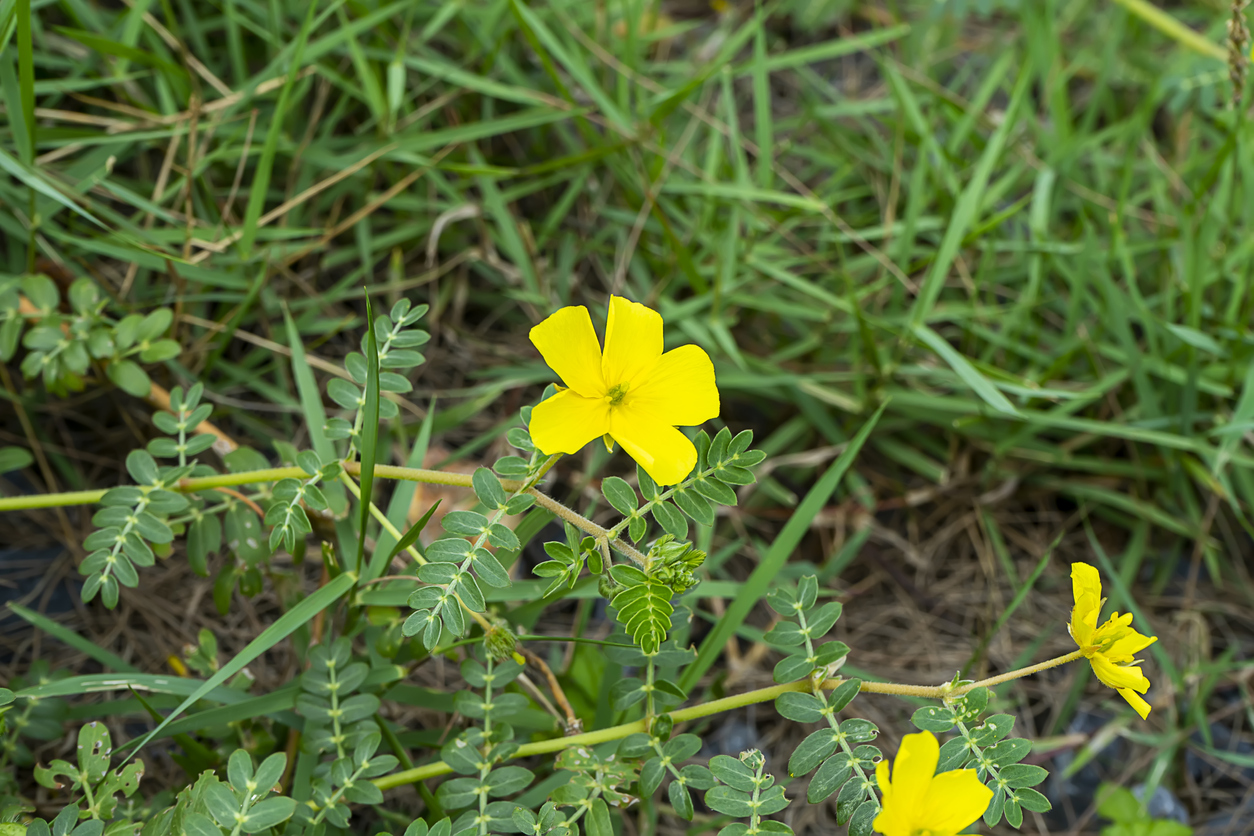
Also called goathead because of their spiky seed capsules that form from tiny yellow flowers, puncturevine is harmful to lawns and doubly so for bare feet. The weed has sharp, painful heads that hide under its deep mat of small green leaves. Grazing livestock can ingest the burrs, too, and the sharp spines can injure an animal’s digestive tract. Although it’s historically touted as a stimulant for male and female reproduction, goathead’s effectiveness in this arena requires more study.
Puncturevine has deep taproots, low growth, and efficient spread—each plant can produce from 200 to 5,000 seeds a season—all of which can help it overtake lawn turf in a trice. To protect turf and toes, learn to identify puncturevine’s leaves and flowers, and hoe or hand-pull it before goatheads form. Mowing won’t kill this monster, either. If you must resort to chemical control, choose a broadleaf herbicide that’s safe for your turf.
RELATED: Solved! Does Salt Kill Weeds?
11. Chickweed (Stellaria media)
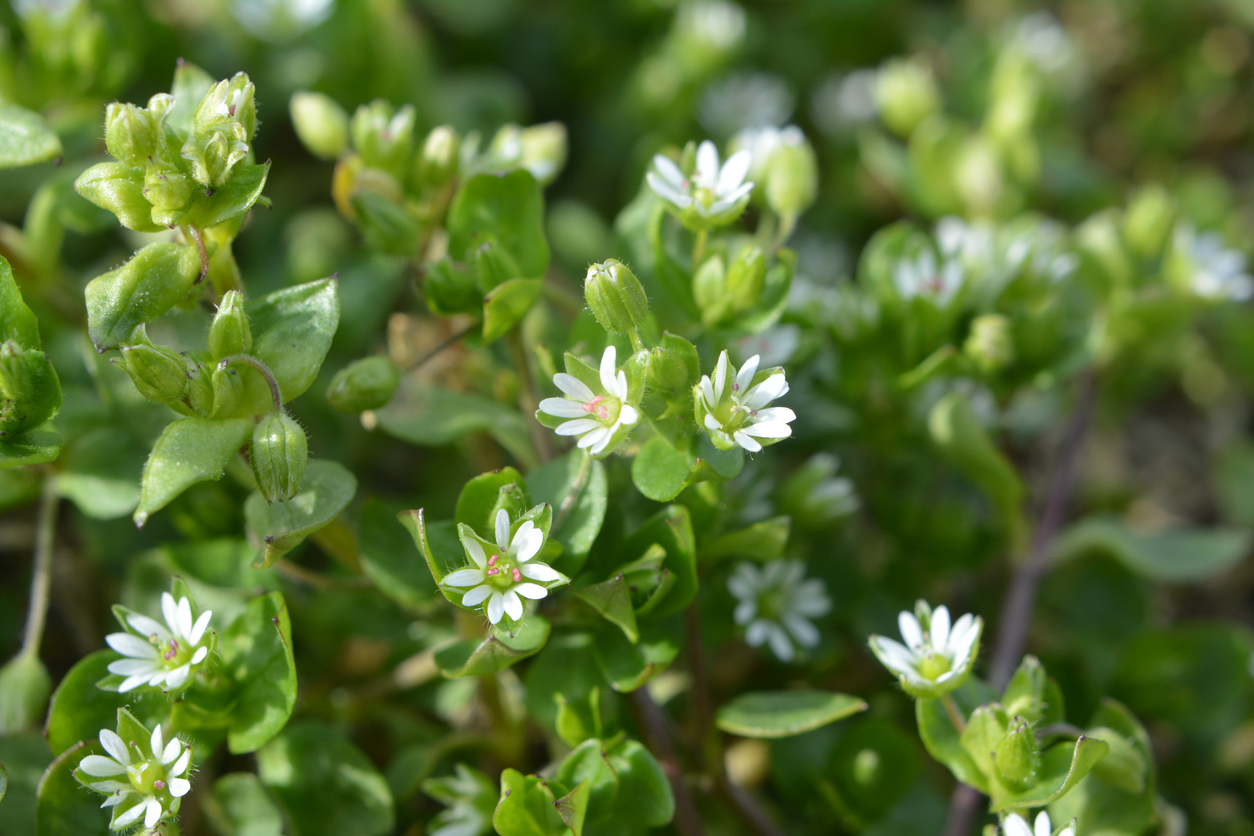
Common chickweed is a winter annual broadleaf weed that spreads in turf at just 2 inches above soil level, though it can grow taller if left unchecked. Its stems are hairy on one side, and the leaves of sticky chickweed also are hairy. The small, egg-shaped leaves grow opposite each other, and tiny white flower clusters appear in spring. The European plant came to America with immigrants who treasured it as an herb, and although its flowers and leaves are edible, they can cause stomach upset if too many are eaten. It’s delicious in salads or stews, and good feed for chickens and pigs. Birds eat the weed’s seeds.
Chickweed can be difficult to remove from your lawn if it forms a dense mat that allows its stems to root. The trick to chickweed control is to prevent the flowers from seeding. In most cases, hand-pulling chickweed is enough to control it. Be sure to toss the pulled weeds into the trash; if left in a moist area of the yard, they can reroot. Herbicide application isn’t really worthwhile with chickweed unless you want to clear chickweed from a large patch of ground.
RELATED: I Let My Lawn Grow for No Mow May—Here’s What Happened
Tips for Lawn Weed Control
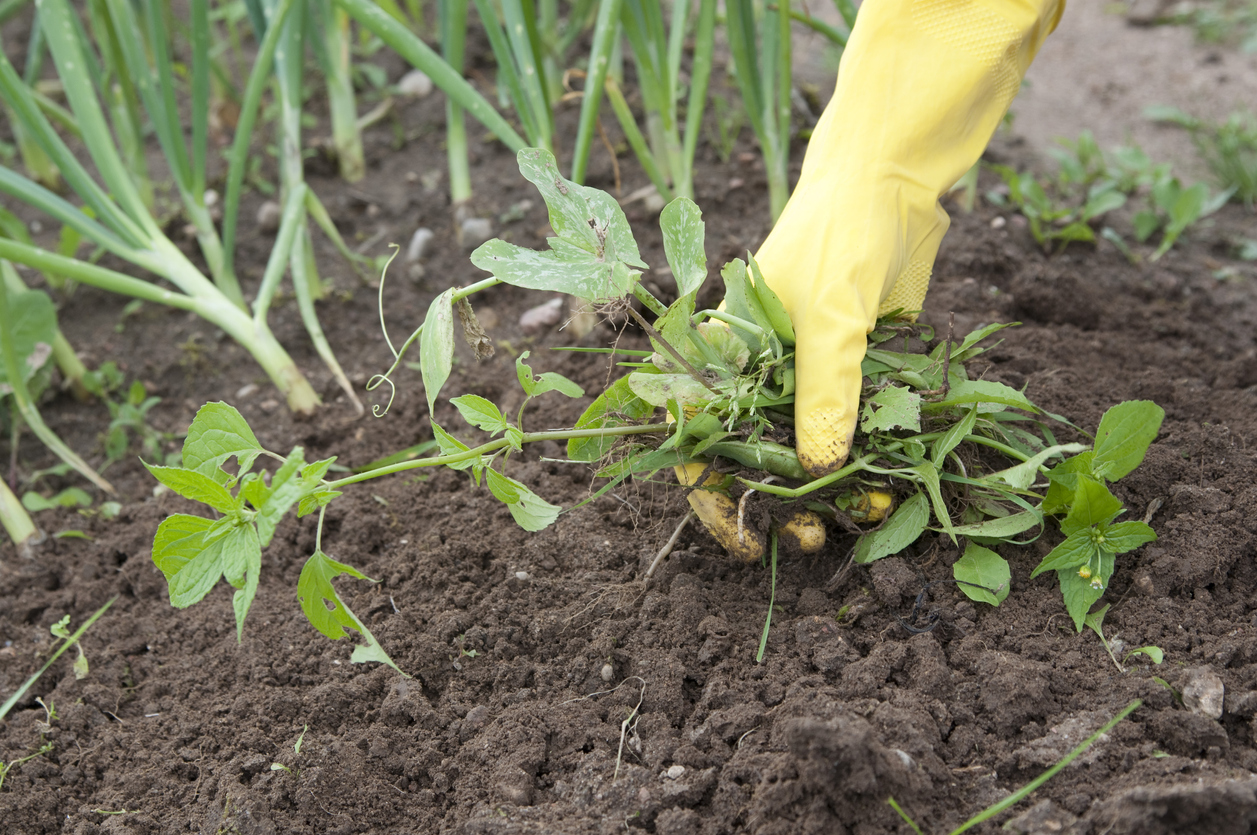
Weed control is part of every successful lawn maintenance plan. Here are some steps you can take to ensure that your grass remains weed-free.
- Mow the lawn higher, and only as needed. Frequent mowing weakens grass and exposes the soil so weed seeds can germinate. When they’re cut often, grass blades won’t develop the side shoots required to create a denser lawn. Mow frequently enough to maintain a lawn height of 3 to 4 inches.
- Water the grass infrequently, but deeply. Lawns require about an inch of water per week—any more than that and you’re inviting disease. Water deeply to promote a stronger root system, but only when there hasn’t been sufficient rainfall. A rain gauge positioned in the landscape can help you determine how much precipitation you are getting.
- Pull weeds when soil is damp. Hard soil is reluctant to release weeds. Wait a day or two after rainfall to take on hand-pulling or digging.
- Never allow weeds to go to seed. A weed flower is a sure sign that the plant is preparing to set seed. Cut it down to prevent it from spreading.
- Dig or till the lawn only if it’s absolutely necessary. There are thousands of weed seeds just below the surface of the soil, waiting to be exposed to the sun. The more you disrupt soil in your beds and lawn, the more you increase the likelihood that those seeds will germinate.
- Mulch landscape beds. Mulch stops the germination of weed seeds by preventing sunlight from reaching them.
- Fertilize lawns appropriately. Apply the right amount of fertilizer at the right time, according to the product’s instructions, to grow a healthy, weed-free lawn.
